Franklin’s Palindromedary Help
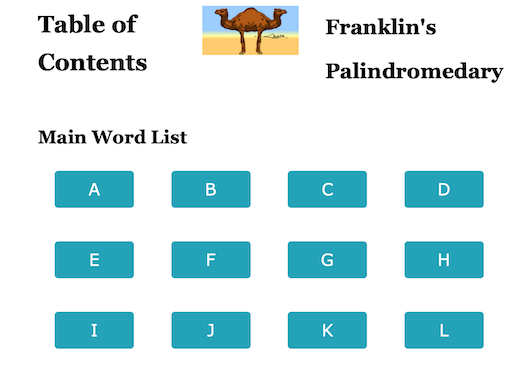
Franklin’s Palindromedary is a collection of five specialized word lists designed to support palindrome composition. Each list has a particular use, described below.
Main Word List
The Main list is arranged much like a dictionary. Each entry begins with a word likely to be in many dictionaries. The entry also contains the reversed word, and what I call splits of the reversed word. Here's a sample entry.
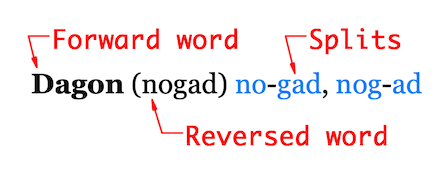
Each entry begins with a word in boldface. This is the entry word, displayed as it would appear in written prose. I also call this the forward direction because it reads in the standard direction for the language of the Palindromedary. In English, the direction is left to right.
Every entry in the Palindromedary appears because it has at least a chance of being useful for palindromes. That is a fundamental rule. I discarded thousands of words because the reversed word has virtually no chance of working in a palindrome. This rule applies throughout the Palindromedary in multiple ways. It filters out words that would only waste your time and greatly improves the odds of composing an original palindrome.
Immediately after the bold entry word is a word in parentheses. This is the reverse of the entry word. In short form, I call it reversed. Sometimes, just seeing the entry and reversed words next to each other can inspire a new palindrome. I chose this pattern because I've always found it difficult to mentally reverse long words correctly.
The rest of each entry is a list of splits. Every entry has at least one split. Some have many. The purpose of the splits is to reveal ways to use the reversed word in a palindrome. Most reversed words look like gibberish, but splitting a word can turn gibberish into poetry. Splits come in two forms: two-way and three-way.
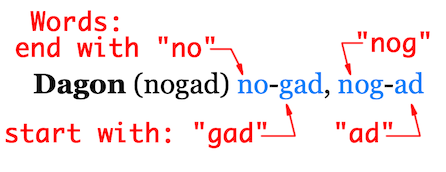
Two-way splits have exactly two parts. I call these parts fragments. Each fragment in a split has one or more forward words associated with it, and that is exactly what you need. Finding a word that matches a fragment expands that reversed word, adding one small bit to your emerging palindrome. The left fragment matches words that end in that fragment. The right fragment matches words starting with that fragment. I'll say more about these matches soon.
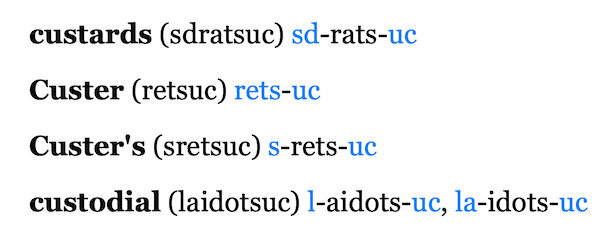
Three-way splits have a slightly different pattern than two-ways. The far left and far right fragments are exactly like those in a two-way split. Left matches words ending with left. Right matches words beginning with right. The middle section is a collection of consecutive whole words. It is not a fragment.
The notion of whole words gets a bit weird because the original word list included a large number of initialisms and acronyms. English has become so cluttered with these fake words that almost any combination of letters can be a legitimate initialism, which makes it a word. In addition, the single-letter words "I" and "a" must be considered words because they are.
I had no reasonable way to check these consecutive words for grammatical correctness. Nor did the algorithm try to find all possible consecutive word combinations. It stopped looking once it found a single sequence of words and marked that middle chunk of text as valid.
What this means is that you need to look at the middle chunk and find the words in the text. Sometimes it is obvious. Other times the text can be a real head-scratcher. If I can't make sense of the middle chunk when I'm considering a three-way split, I skip it and move on to the next split. I might find a practical way to fix this situation in a future edition. For now, it is what it is.
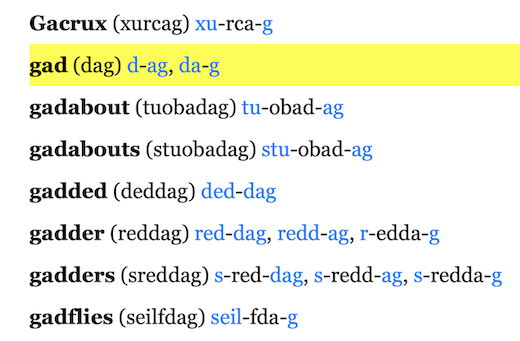
The real value of every split is the associated word list. To see that list, just click a fragment link. A right fragment links to the first word in Main that begins with that fragment. From there you can scan the rest of the matching entries and choose a word that might work in your palindrome.
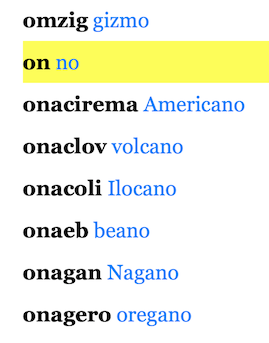
Left fragment links go to the first matching word in the Reversed list. In this case, the fragment matches words ending with that fragment. The Reversed list groups words in this way inherently. Keep reading to learn how.
Reversed Word List
The Reversed word list is exactly what it sounds like. It is a list of ordinary words printed in reverse. What makes it useful is that the list is ordered alphabetically by the reversed words. Each entry also includes the forward word. This combination groups words by the way they end. All words that end in "d" are together, as are the words that end with "ed" and "ted" and "sted" and so on.
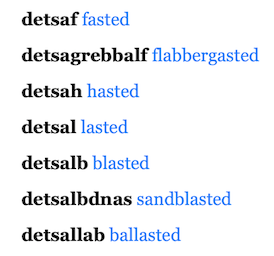
Just as reading a dictionary can improve vocabulary, reading the Reversed word list can improve your palindromes. It can be a source of inspiration for a new palindrome, revealing a word you never expected to be hidden inside the reverse. It can also expose relationships between words that you hadn't suspected.
Reading the Reversed list might even improve your vocabulary. Just remember to add the forward words and not the reversed. We already have enough trouble understanding each other without tossing reversed words into the pot.
Palindrome Word List
Palindromic words are so special, I thought they deserved their own list. For some people, palindrome means palindromic words. Either way, it's a fun list, though short.
The two previous lists, Main and Reversed, have a full section for each letter of the alphabet, and sub-sections spanning a shorter grouping. English has so few palindromic words, they all fit into four sections.
Each entry is just a single word, linking to the same word in Main. As you might have guessed, each word is perfectly symmetrical. This list is short enough to read in a few minutes, and I highly recommend it. Some you may already know. Others could be unfamiliar.
This list can also be a source of inspiration. Any palindromic word fits perfectly into the exact middle of a palindrome, as long as the grammar makes sense. With a little effort, it might even fit off-center if the splits are copacetic.
Ananym Word List
The Ananym list is a large list, in part because it has an entry for each word in the pair. The entries are simple. First is the word, followed by the reversed word. Both the forward and reversed words link to entries in Main. The entry pattern is similar to Reversed, though the entries are in ordinary alphabetical order.
Verb Word List
Sometimes you just need a verb. This list contains verbs that are also useful for palindromes. Each link goes to the word entry in Main. It shows the reverse so you can get a sense of the split opportunities. Click the link to see the useful splits.
List Navigation
From the main site, selecting the Franklin’s Palindromedary link displays the Table of Contents in a new tab. It displays buttons linking into each list. The lists Main, Reversed, and Ananym have a button for every letter of the alphabet. The Palindrome and Verb lists are much shorter and so have fewer buttons.
Every page in a list has a set of navigation links. You can always return to the Table of Contents by clicking the link in the top right of each page. In addition, just above the entries, is a set of buttons for moving around inside the list.
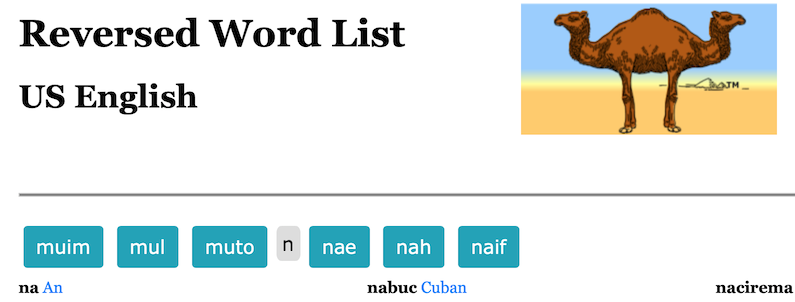
The image shows the first page for letter N in the Reversed list. Buttons to the right load nearby pages in the N sub-section. Buttons to the left open adjacent pages in the M sub-section. This pattern lets you browse into a letter section from the beginning or end. From the N page, you can see reversed words ranging from muim to naif. Clicking the far left or far right button skips backwards or forwards by three pages at a time.
